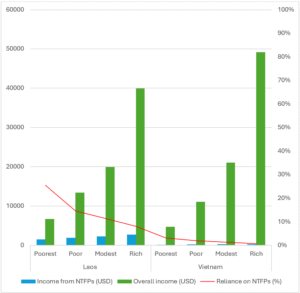Non-timber forest products (NTFPs) play an essential role in rural livelihoods across the Global South. However, this role changes as agricultural production commercialises, forest is lost, and non-farm activities become available. Recent research in northern Laos (Houaphan Province) and Vietnam (Son La Province) shows that the share of income from NTFPs decreases and the total income from NTFPs increases as households become richer. But patterns are strikingly different across the two countries.

Main messages of the chart
Households in Laos earn more from NTFPs – things like bamboo, forest foods, and wild fish – than households in Vietnam. Total household income (green bars) is similar in both countries, but the forest-based part (blue bars) is much larger in Laos. Lao families use these products for food at home and cash. In Vietnam, the small blue bars and low red line show that people have largely moved away from forest use because farming has become more intensive and forest rules are stricter. Vietnamese households have substituted many forest products with on-farm alternatives, for example growing fodder instead of collecting it, or sourcing firewood from private fruit tree plantations rather than from forests. In both countries, poorer households with little farmland rely more on NTFPs, yet they still earn less in total from them.
Implications of the findings
These differences suggest that national policies, local rules, and the health of forests matter more than where a village is located in shaping how rural communities interact with their environment. This means that ‘one-size-fits-all’ policies won’t work. In Laos, poorer households depend heavily on forests as a safety net; in Vietnam, that is less the case. Effective forest conservation must consider how people make a living and recognize that forests play different roles in different places. Families combine many activities – some for selling, some for home use – to get by and improve their incomes. Rural programs that focus only on selling to markets risk overlooking the many ways forests support households.
Data sources
The study is based on household survey data collected from 164 households in Houaphan, Laos, and 156 households in Son La, Vietnam, spread across 11 villages in both highland and lowland areas. Net cash and subsistence incomes were measured over the preceding 12 months at the time of data collection in 2023.
To learn more
Persson, J. (2025). Livelihood commercialisation and resource use across the border: Explaining environmental income differences in northern Laos and Vietnam. Forest Policy and Economics, 177, 103529. https://doi.org/10.1016/j.forpol.2025.103529






